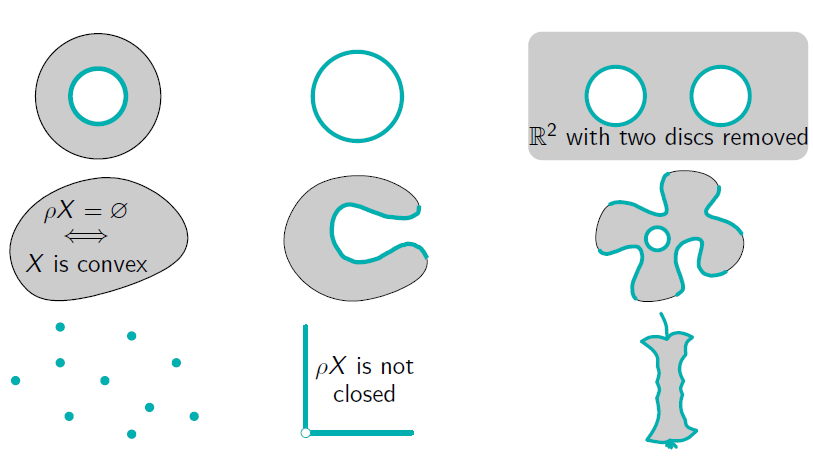Abstract
I will present a theorem describing when two closed subsets X and Y of Euclidean space have the same magnitude homology in the following strong sense: there are distance-decreasing maps X \to Y and Y \to X inducing mutually inverse isomorphisms in positive-degree magnitude homology. The theorem states that this is equivalent to a certain concrete geometric condition. This condition involves the notion of the “inner boundary” of a metric space, which consists of those points adjacent to some other point. The proof of the theorem builds on Kaneta and Yoshinaga’s structure theorem for magnitude homology.
The slides can be found on Tom Leinsters Webpage. https://www.maths.ed.ac.uk/~tl/
How do you type everything so quickly and concise? Do you sometimes have issues prioritizing important stuff? Do you do this outside of the n-category (to remember lectures?). How do you use the notes in the future?
Motivation
Two Homotopic Maps induce the same homology map. Is there an analogous relation between functions that preserve magnitude homology?
Review Homology
We construct a homology of a category
Construction
Take an ordinary category . We can construct a chain complex as follows: Does mean the same as ? There is a differential where removes the -th term by merging or forgets the first or last factor.
We now generalize to enriched cats (see Roff - Iterated Magnitude homology). The ingredients generalize in the following way:
Magnitude ingredients
A Magnitude is given by
- a monoidal category
- a ring
- A size homomorphism from the cat to the ring
A magnitude homology
- needs a specialized semicartesian monoidal category
- a monoidal abelian category (can multiply)
- a strong symmetric monoidal size functor
We want to define a homology for the enriched version too.
Magnitude homology enrichted category
Now define a chain complex as before. Define the differential in the same way. This gives a chain complex which results in a homology theory. The chain complex is The magnitude homology is gotten by taking the quotients of the chain complex.
Now we specialize to metric spaces again.
Magnitude homology metric space
For the specialization we need
- monoidal abelian category
- string monoidal functor
Could you explain the terminology?
I skip the concrete definition since it is given in Magnitudenhomologie (Metrischer Raum)! This homology theory is -graded homology theory!
Sample results
- Let be a closed subset of Then And if convex then for all and .
- The magnitude homology tells you how big a from cut out hole is (Ryuki Kante &Yoshinaga). e.g. Let and Then
Slogan: The more geodesics are unique the more magnitude homology is trivial!
Preparation Main theorem
What does is mean that two objects have homology?
- Of of the Homology groups are isomorphic (not useful)
- There is a map inducing an iso
- There are two maps between and going in opposite direction, inducing mutually inverse homology maps
Inner boundary of a metric space
Adjacency
Two points are adjacent, if two points are distinct and there is no point in between. The Inner boundary ist the set points which are adjacent to another point. of all adjacent points.
 We are using the metric of the ambient space!
We are using the metric of the ambient space!
Closure of the inner boundary and hull
is the closure of the inner boundary. The is the intersection of the hull with the Set.
Main Theorem (Leinster & Mateo)
Take two sets of . Then two spaces are magnitude homologic, if
- there are distance-decreasing maps inducing mutually inverse magnitude homology maps for all
- there are distance-decreasing maps inducing mutually inverse magnitude homology maps for some
- The and are isometric.
The Proof
The ingredients:
- Kante and Yoshinagas structure theorem for magnitude homology
- An analysis of when two maps of metric spaces induce the same map in magnitude homology
- Some convex geometry
I’ll skip over the rest as I dont think it is very important.
Straight metric spaces
Definition straight metric spaces
is the set of all points, which sit between . Call as a space straight, if any points in sa suitable order devide the space.
i.e. the betweenness relation behaves as in subsets of .
Kaneta and Yoshinagas structure theorem
An Element of is an equivalence class of cycles .
Thinness
An -Tuple of points ist thin if.
- and are adjacent for all .
- is not between and for any .
Then every is in and is automotaically a cycle.
Points like be above will not be found in graphs but can be found on the border of closed euclidian sets.
Theorem
If is straight then ist freely generated by the set of thin -tuples
A corollary of the above is the following:
Corollary
Let be a straight metric space. Then any retract of containing its inner boundary has the same homology as .
When are two maps the same in homology?
Theorem
Take maps of metric spaces with straight. If , then are chain homotopic in degree and therefore the induced maps are equal.
When does a self-map induce the identity in homology
Theorem
Let be a straight metric space. The following conditions on a self-map are equivalent.
- is the identity for all
- is the identity for some
- is the identity on the inner boundary of